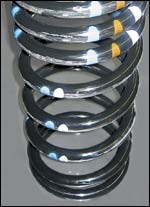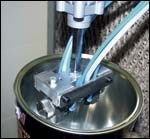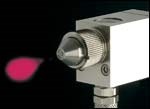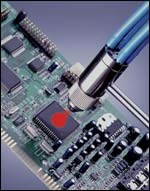Precision Spraying Makes Its Mark
Handling minute quantities of spray material requires specialized coating equipment...
Spray coating technology is required not only for objects with large surface areas but also for jobs that need an absolutely precise application of small quantities of paint. Such processes may not be quite as spectacular as, for example, finishing a whole car body, but they are nevertheless very complex procedures. Precision spraying equipment can handle not only spray coating but is also used very successfully for marking or spray coding industrial components.
Regardless of the application, precise handling of minute quantities of material makes extreme demands on the coating equipment. This means that manual spray guns are ruled out from the start—application of a tiny dot of paint with absolute precision requires the use of automatic spray guns with extremely short switching times.
Spray Equipment
These solenoid valve-controlled spray guns have to open and close very quickly, taking just milliseconds to release minute quantities of paint. But precision coating takes more than just high switching frequencies alone. Guns also must provide reproducible spraying results over a long period of time.
Because such fine spraying work requires very small nozzle diameters, it is essential to prevent material residues or droplets of paint from accumulating at the nozzle. Therefore, such guns always work with air atomization. These models have a “pre-air” setting, which means that the material being sprayed is not released until the atomizing air is already flowing. This prevents droplets from forming at the nozzle. Stopping the material supply before shutting off the atomizing air prevents drips of material when the gun closes after spraying.
The spray gun itself is part of an integrated system, which generally consists of the material supply components, a compressed air system, a solenoid valve and, if required, an overspray extraction system. Use of pressure tanks to supply the very small quantities of material being sprayed in such cases is recommended. Pressure tanks provide the constant material pressure required to ensure reproducible results while guaranteeing that the material is safely and securely stored. Products supplied by our company include galvanized or stainless steel tanks and containers in all sizes.
Another essential system component is a maintenance unit with a compressed air filter that meets the highest demands. Control cabinet designs are available with all the necessary pneumatically or electrically controlled functions and are matched to the requirements of each spraying system. This is the best way to take into account additional parameters such as pressure or level monitoring. In certain circumstances, an overspray extraction system is required not only to remove overspray particles but also to extract solvent vapors from the spraying area.
Absolute Precision
Such high-precision spraying systems need to be custom built for most applications; there are practically no “off-the-shelf” systems. For each application, the different parameters—the type of object and its surface, the coating material and the spraying system—must be ideally matched. Our company has collected extensive data on this subject and also offers testing capability.
Sometimes, the job is made even more complicated by difficult circumstances. For example, precision coating in areas that are difficult to access is a particular challenge. In one case, the anti-corrosion coating inside cans was being damaged at two places when the handle lugs were welded onto the cans. We designed a spraying system for this customer that accurately meters the amount of coating needed to precisely repair the damage with a short cycle time. The system is fitted with two miniature automatic spray guns, allowing the two points to be coated in a single process.
Generally, for hard-to-reach areas or complex part geometries, efficient spraying equipment with precise metering of the material quantity is absolutely essential. This is particularly true for robotic spray guns with a compact design. In this case an external control system for wide or round jets allows the spray jet to be optimally adapted to changing part geometries.
Further fine adjustment of the spray jet can be achieved by adjusting the supply pressure at the pressure tank. Depending on the application, precise coordination between the different parameters of nozzle size, material pressure, atomizing pressure and spraying distance allows coatings to be applied with precise edge definition and minimum overspray. This eliminates the need for patterns or masking when, for example, coating the joints of plastic ‘brick effect’ wall cladding.
Spray Marking
Precision spraying is also used for part marking, in particular for marking defects after nondestructive material testing has been carried out. When parts are marked by spraying, no contact is made with the part. For this reason, spray marking is particularly useful for machined or formed metal parts. Example applications in metalworking include marking weld seams on sheet metal or tubes as well as marking engine blocks, crankshafts and camshafts after they have been tested for sealing, quality, balance and mounting position.
Spray marking is also used in other industrial sectors, for example to highlight blowholes in glass. In this application an electronic fault detection system triggers the automatic spray gun, which then makes a dot or a mark on the defective product. The highly reproducible process ensures that every mark is clear and accurate, even at high throughput rates. Marking can take place in any position. It is also possible to have special gun arrangements that allow parts to be marked in different colors to indicate various defect criteria.
Marking can be used for process control and monitoring—for example, to mark the location at which a weld seam is to be placed or where a pipe is to be bent. It can also be used to mark cutting or folding lines on cardboard packaging, and small spray marks can be applied as a visual indicator to operators to ensure correct assembly of parts. Examples of this type of use are when installing control buttons for heating regulators or filters for catalytic converters.
To differentiate parts that have a similar appearance, they can be marked in different colors—for example, for classifying oil seals or the springs of shock absorbers. Precision spraying is also useful for improving the legibility of inkjet marking on certain substrates. The spray gun first sprays a background onto which the actual inkjet mark is then applied.
Spray Coding
Spraying is also used for code marking in the metalworking industry. Strips, panels, pipes, profiles or coils can be spray coded in a continuous process to allow them to be classified for logistical purposes. Alphanumeric identification codes can be produced by five, seven or nine spray guns fixed to an adapter plate. Each of the guns opens for just a fraction of a second, spraying a single dot. Depending on the gun arrangement, a sequence of several dots produces a matrix that becomes a legible alphanumeric character.
A control computer determines the precise dot sequence and synchronizes marking with conveyor speed. This ensures that the spray image remains constant even if conveyor speed varies.
The guns’ extremely short switching times mean that high conveyor speeds are possible. Height of the characters can vary from 40 to 200 mm, and dot size and coating thickness can be adjusted at the guns.
The rapid opening and closing sequences required for spray coding place extreme stress on the guns, and marking inks are special and in some cases highly abrasive materials. For these reasons, we have developed guns for spray coding that work without needle sealing and instead use an almost non-wearing diaphragm. Such new developments provide a good solution to problems not only for spray coding but also in other sectors of industry.
Walther Pilot North America, LLC
Related Content
Shedding Light on Surface Inspection
State-of-the-art reflector-based lighting system improves luminosity and ergonomics for surface inspection tasks while reducing energy usage.
Read MoreThe Value of Robotic Paint Performance Testing
Considerations for implementing the use of automation for paint performance testing.
Read MoreZinc Phosphate: Questions and Answers
Our experts share specific questions about zinc phosphate and pretreatment
Read MoreTTX’s Automated Conveyor Carrier System Offers Wireless, Flexible Operation
ACC system designed for reliable, consistent point-to-point movement of everything from small to heavy parts.
Read MoreRead Next
A ‘Clean’ Agenda Offers Unique Presentations in Chicago
The 2024 Parts Cleaning Conference, co-located with the International Manufacturing Technology Show, includes presentations by several speakers who are new to the conference and topics that have not been covered in past editions of this event.
Read MoreEducation Bringing Cleaning to Machining
Debuting new speakers and cleaning technology content during this half-day workshop co-located with IMTS 2024.
Read MoreDelivering Increased Benefits to Greenhouse Films
Baystar's Borstar technology is helping customers deliver better, more reliable production methods to greenhouse agriculture.
Read More


























